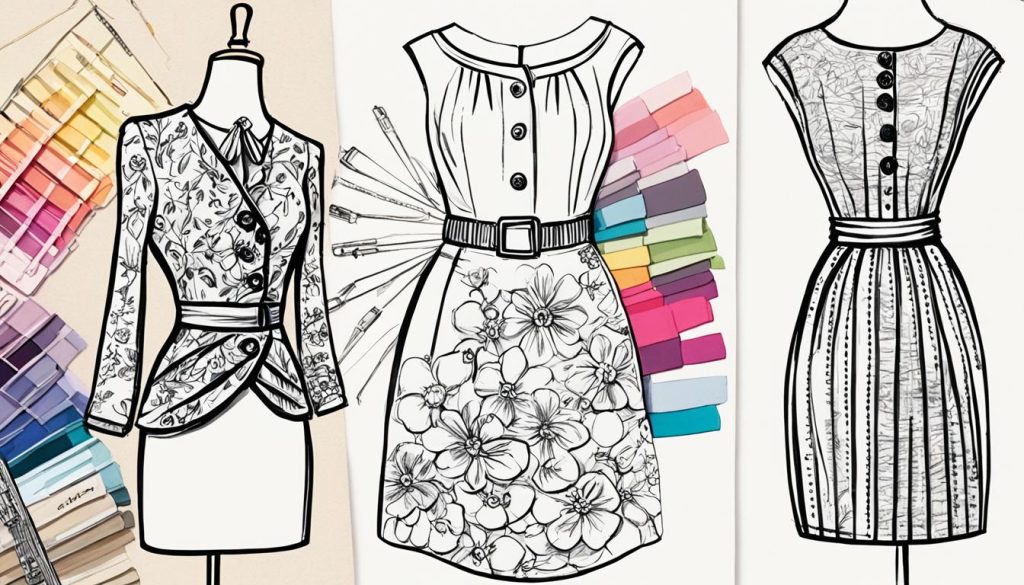If you’ve ever dreamed of starting your own clothing brand, now is the perfect time to make it a reality. The fashion industry is thriving, and with the right steps, you can carve out your own niche and create a successful clothing brand. Whether you’re interested in designing luxury clothing or launching an affordable apparel line, this article will guide you through the essential steps on how to start a Clothing brand.
We’ll explore how to develop your fashion design skills, create a comprehensive business plan, build a strong brand, design your clothing line, and market your business effectively.
Understanding the Fashion Industry Landscape
The fashion industry landscape is a dynamic and multifaceted sector encompassing design, production, marketing, and retailing of clothing, accessories, and footwear. It thrives on creativity, trends, and consumer preferences, constantly evolving to meet changing demands and styles. From high-end luxury brands to fast fashion retailers, the industry caters to a diverse market audience with varying tastes and budgets.
Key players in the fashion industry include designers, manufacturers, wholesalers, retailers, and fashion influencers who shape and drive trends through collaborations, runway shows, and social media presence. Sustainability, ethical practices, and inclusivity have become increasingly important considerations within the industry, prompting a shift towards more transparent and responsible business practices.
Understanding the fashion industry landscape involves navigating global supply chains, digital marketing strategies, seasonal collections, and emerging technologies to stay competitive in this ever-evolving sector.
Develop Your Fashion Design Skills
In order to start a luxury clothing brand, it is crucial to develop strong fashion design skills. This section will provide you with valuable tips and resources to enhance your expertise in the fashion industry.
Formal Education in Fashion Design
One of the most effective ways to acquire comprehensive fashion design skills is through formal education. Enrolling in a reputable fashion design program will provide you with the necessary knowledge and practical experience to excel in the field. Look for renowned fashion schools such as the London College of Fashion or the Central Saint Martins to gain insights from industry professionals and establish a strong foundation in design techniques and fashion trends.
Small Business Programs
Aspiring fashion designers also benefit from participating in small business programs, such as those offered by Enterprise Nation or The Prince’s Trust. These programs specialize in supporting and mentoring entrepreneurs in the fashion industry, providing valuable guidance on business strategies, branding, and marketing.
Online Courses and Resources
For those unable to attend a traditional educational institution, online courses and resources offer a flexible and convenient option. Platforms like Udemy and Coursera provide a wide range of fashion design courses taught by industry experts. These courses cover various topics, including fashion sketching, pattern-making, and garment construction.
Additionally, numerous websites and blogs dedicated to fashion design offer valuable insights, tutorials, and inspiration to aspiring fashion designers. Websites such as Vogue UK and Fashion United provide the latest updates on fashion trends, interviews, and industry news.
Real-World Experience and Mentorship
Gaining real-world experience and learning from professionals in the fashion industry can significantly enhance your fashion design skills. Consider interning at established fashion houses, working with experienced designers, or seeking mentorship opportunities. This hands-on experience will not only improve your technical skills but also expose you to the practical aspects of running a successful luxury clothing brand.
Remember, developing strong fashion design skills is an ongoing process. Continuously refine your techniques, stay updated on emerging trends, and never stop learning from industry experts.

How to Start a Clothing Brand?
When starting a clothing brand, it is essential to have a well-crafted business plan. A comprehensive business plan will serve as your roadmap, guiding you through the various stages of launching and growing your fashion label. Here are the key steps to creating a clothing business plan:
1. Understand Your Target Market
Before diving into the details of your business plan, it’s crucial to have a clear understanding of your target market. Identify your ideal customer demographics, their preferences, and their shopping behavior. This will help you tailor your brand and products to meet their needs, giving you a competitive advantage in the market.
2. Define Your Brand Identity
Your brand identity is what sets you apart from other clothing brands. Clearly define your brand’s values, mission, and unique selling propositions. Consider the style, aesthetic, and message you want your brand to convey to your target market. This will help you develop a brand identity that resonates with your customers and creates a lasting impression.
3. Create a Sales Strategy
To successfully launch and grow your fashion label, you need a solid sales strategy. Determine how you will reach your target market and sell your products. Will you focus on online sales through your website or e-commerce platforms? Will you partner with retail stores or participate in fashion trade shows? Define your distribution channels and marketing strategies to maximize your brand’s visibility and sales.
4. Choose Your Business Model and Consider Costs
There are different business models to consider when starting a clothing brand. You can opt for hand production, manufacturing partnerships, or print on demand. Each model has its advantages and considerations in terms of production costs, scalability, and quality control. Evaluate the pros and cons of each model and determine the most suitable one for your brand.
5. Create a Financial Plan
A clothing business plan should include a detailed financial plan that outlines your startup costs, ongoing expenses, and projected revenue. Consider all aspects of your business, including product development, manufacturing, marketing, and operational costs. This will help you assess the financial viability of your clothing brand and plan your budget accordingly.
6. Consider Funding Options
If you are starting a clothing brand with little to no money, exploring funding options is crucial. Research grants, loans, angel investors, or crowdfunding campaigns that can provide the necessary capital to launch your fashion label. Be prepared to articulate your business plan and demonstrate the potential return on investment to secure funding.
Creating a clothing business plan is an essential step in launching a successful fashion label. It provides a roadmap for your brand’s development and ensures you have a clear vision and strategy in place. With a well-crafted business plan, you’ll be well-prepared to navigate the competitive landscape and turn your clothing brand dream into a reality.

Build a Strong Brand and Design Your Clothing Line
Building a successful clothing brand in the UK requires a strategic approach that encompasses both brand development and product design. Firstly, establishing a strong brand identity that resonates with your target audience is crucial. This involves defining your brand values, mission, and unique selling proposition, as well as creating consistent visual elements across all marketing channels.
When it comes to designing your clothing line, staying updated on fashion trends and understanding your market’s preferences are key. Conduct thorough market research to identify opportunities and create designs that meet consumer needs. Sourcing high-quality fashion fabrics and setting up efficient production processes are vital steps to ensure the quality and consistency of your products.
Pricing strategies, inventory management, seasonal planning, and retail partnerships play a significant role in driving profitability and expanding your brand’s reach. Leveraging online platforms for sales and marketing, including e-commerce websites and social media, can enhance brand visibility and customer engagement. By focusing on these aspects, you can build a successful and profitable clothing brand that stands out in the competitive UK fashion market.

Establish an Online Presence
Establishing an online presence for a clothing brand is essential in today’s digital age to reach a wider audience and drive sales. To start, create a visually appealing and user-friendly website that showcases your clothing line, provides detailed product descriptions, and offers a seamless shopping experience.
Utilize social media platforms like Instagram, Facebook, and Pinterest to engage with your target market, share captivating visual content, and build a community around your brand. Invest in search engine optimization (SEO) to improve your website’s visibility in search results and attract organic traffic. Implement email marketing campaigns to nurture customer relationships, promote new collections, and drive conversions.
Collaborate with fashion influencers or bloggers to expand your reach and increase brand credibility. By employing these strategies cohesively, you can effectively establish a strong online presence for your clothing brand, connect with customers, and elevate your brand recognition in the competitive fashion industry.
Implement Marketing Strategies
Implementing effective marketing strategies for a clothing brand is crucial for attracting customers, driving sales, and building brand awareness. Start by defining your target audience and creating tailored messaging that resonates with their style preferences and lifestyle.
Utilize a mix of online and offline channels such as social media advertising, influencer partnerships, email marketing, and collaborations with fashion bloggers to promote your brand and engage with potential customers. Develop compelling visual content, including high-quality photos and videos showcasing your clothing line, to captivate audiences and showcase your unique brand identity. Consider hosting events, pop-ups, or fashion shows to generate buzz, create experiential marketing opportunities, and connect with your community.
Monitor and analyze the performance of your marketing campaigns to optimize strategies, identify trends, and ensure a consistent brand voice across all touchpoints. By implementing a comprehensive and targeted approach to marketing, you can effectively position your clothing brand, attract loyal customers, and drive long-term success in the competitive fashion industry.
Build Customer Relationships

Building strong customer relationships is paramount for a clothing brand looking to foster loyalty, trust, and repeat business. Start by understanding your customers’ preferences, needs, and feedback through regular communication and engagement. Offer exceptional customer service by providing personalized shopping experiences, addressing inquiries promptly, and resolving issues effectively.
Implement a customer loyalty program to reward repeat purchases and encourage brand advocacy. Create meaningful interactions with your audience through social media engagement, email newsletters, and exclusive offers to build a sense of community and connection. Actively seek and incorporate customer feedback to continuously improve your products, services, and overall customer experience.
By prioritizing customer relationships, demonstrating genuine care, and delivering value beyond transactions, your clothing brand can cultivate lasting connections, brand advocacy, and sustained success in the competitive fashion industry.
Stay Adaptable and Innovative
In the fast-paced and ever-evolving fashion industry, staying adaptable and innovative is essential for a clothing brand to remain relevant and competitive. Embrace change by monitoring industry trends, consumer behaviors, and market shifts to anticipate and meet evolving demands.
Stay agile in response to feedback, adapting product offerings, marketing strategies, and customer experiences to align with changing preferences and expectations. Foster a culture of creativity and innovation within your brand, encouraging experimentation, and exploring new ideas to differentiate your brand and stay ahead of the curve. Embrace technology and digital advancements to streamline operations, enhance customer interactions, and leverage data-driven insights for informed decision-making.
By remaining adaptable and innovative, your clothing brand can navigate challenges, seize opportunities, and sustain growth in an ever-changing fashion landscape.
Conclusion
Successfully starting a clothing line requires a meticulous approach that integrates fashion design skills, strategic planning, brand development, product design, and marketing efforts. Entrepreneurs must focus on honing their design abilities, crafting a comprehensive business plan, and establishing a strong brand identity.
By sourcing quality materials, creating compelling designs, implementing effective pricing strategies, and leveraging online platforms for sales and promotion, aspiring clothing entrepreneurs can set themselves up for success in a competitive market.
While profitability in the clothing business is achievable, it hinges on factors like product quality, market positioning, and customer engagement. With dedication, creativity, and a well-defined business strategy, launching a clothing line can be a fulfilling endeavor for those looking to thrive in the dynamic world of fashion.
FAQs
How do I develop my fashion design skills?
Developing fashion design skills can be done through a combination of formal education in fashion design, small business programs, online courses, and gaining real-world experience. Consider enrolling in fashion design courses or programs, attending fashion design workshops, and learning from professionals in the industry.
Why is creating a clothing business plan important?
Creating a comprehensive clothing business plan is crucial as it helps outline your target market, brand identity, and sales strategy. It provides a roadmap for your business, helps you analyze the market, and defines your goals and objectives. A well-crafted business plan also takes into account financial planning and funding options.
How can I build a strong brand and design my clothing line?
Building a strong brand involves defining your niche, developing a brand identity, and creating a consistent brand message. When designing your clothing line, consider sourcing fashion fabrics or designing your own, setting up production and manufacturing, and establishing pricing and inventory strategies. Additionally, plan your collections around fashion seasons and pitch your line to fashion retailers. You may also explore building an online clothing store and focusing on effective marketing strategies.
What are the essential steps to start a clothing brand?
The essential steps to start a clothing brand include developing fashion design skills, creating a clothing business plan, building a strong brand, designing and developing a clothing line, and marketing your business. By following these steps, you can establish a solid foundation for your clothing brand and increase your chances of success.
Is starting a clothing business profitable?
While success and profitability vary across different clothing brands, the clothing industry offers significant opportunities for aspiring entrepreneurs. With careful planning, a strong brand, and the ability to adapt to changing fashion trends, starting a clothing business can be a profitable venture.





